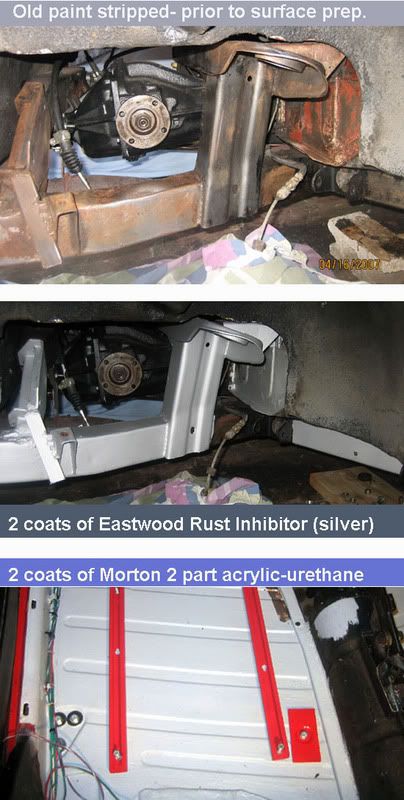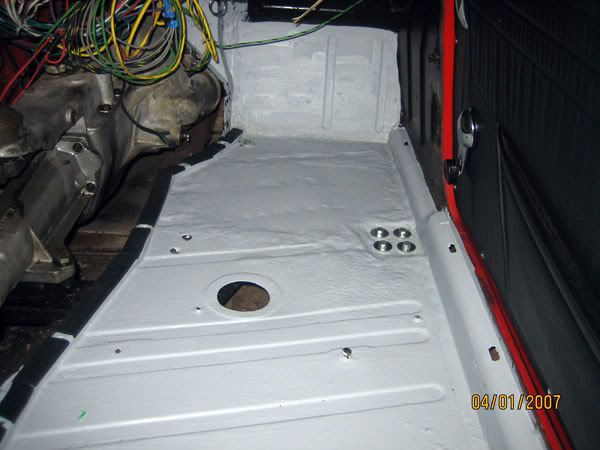T
Tinster
Guest
Guest
Offline
We all remember the mess TRBill got himself into
with his floor rust proof painting. Since I was about to
repair both floor pans right after Bill's nightmare, I did
a little research.
I'll relate my field findings and opinions on two rust paint
products I have now used.
a. Eastwood Rust Inhibitor- xylene based single component
1 quart silver color at $30.00 plus shipping
b. Morton Rust Inhibitor - 2 component acrylic/urethane
1 quart Grey) with 1 pint activator at $25. local.
I will do the write up after/below the photos that follow.

Both products have a very short useful brush life. Both
require small amounts poured or mixed from the parent cans.
With the Eastwood test area on my frame, I chemically
stripped the existing paint, scraped, degreaser cleaned,
then cleaned with xylol, dry sanded rust with 200 paper,
xylol, steel wool, xylol and then painted with Eastwood.
The Eastwood product is a very high xylene solvent based
paint that sets up into tac condition after maybe three
brush strokes. Fastest setting paint I have ever used.
This product requires decisive, long , brush strokes. Don't
even think about going back over it to make the brush lines
all nice and neat and parallel or fix runs and blobs. You'll
just make a mess. Dry to the touch in about 4 to 6 minutes.
I found using a 1.5" wide brush gave me opitmal results with
a decent finished look.
Because the Eastwood is a very high solvent product, it goes
on fairly thick but is pretty thin once the solvents
evaporate and the product has dried leaving behind the
solids. A minimum of two coats is a must, in MHO.
I tested the Eastwood resistance to brake fluid, solvent
based enamel paint and gasoline. All three "ate the paint.
With only 12 hours dry time, the Eastwood scratched easily.
The Eastwood Rust Inhibitor does NOT require burning the
rust or the deep cleaning I performed. It can go directly
over wire brushed rust. (Personally I think only a DPO would
not try to remove MOST of the rust)
I had to have my can of Eastwood barged shipped to PR and
it just arrived last Friday. Something to do with Homeland
Security and certain chemicals prohibited on aircraft.
While waiting for the barge to arrive I went to a local auto
paint shop.
Our local auto paint specialty shop does not carry the
Eastwood lines. My local shop recommended to me the
Morton 2 part acrylic/urethane rust product.
The Morton product is a non-solvent based paint that
requires mixing a catylyst to start off the chemical
reaction. A 4 parts urethane to one part catylyst ratio
is used.
The Morton product also requires use in small batches. It
has about a 20 minute useful brush life. It is possible to
go back over and make nice neat parallet brush lines and fix
drip and blobs. The acrylic/urethane also goes on thick but
retains it aplication thickness becaue it is chemical
reaction cured NOT solvent evaporation based. One coat on
my floor pans was probably good enough but I put on two
"just to be safe". Morton recomends burning the rust and
normal cleaning. I followed this procedure.
I also tested the cured Morton with brake fluid, solvent
based enamel paint and gasoline. There was no reaction or
softening of the acrylic/urethane. After 12 hours the Morton
acrylic/urethane was hard plastic I could not easily cratch.
I think The A/U will better resist road gravel and stones
kicked up from tires, etc.
Bottom line opinion:
I will continue to use the Eastwood product as a two coat
primer on my frame and engine compartment but I will overlay
it with the 2 part- chemically resistant- acrylic/urethane.
In the engine bay I will try to find red A/U top coat paint.
Several forum members are working in engine bays or on their
frames. I hope my observations help a bit.
best regards,
Dale in Sunny Puerto Rico
Yeah, Crypty is on jack stands...AGAIN!!
with his floor rust proof painting. Since I was about to
repair both floor pans right after Bill's nightmare, I did
a little research.
I'll relate my field findings and opinions on two rust paint
products I have now used.
a. Eastwood Rust Inhibitor- xylene based single component
1 quart silver color at $30.00 plus shipping
b. Morton Rust Inhibitor - 2 component acrylic/urethane
1 quart Grey) with 1 pint activator at $25. local.
I will do the write up after/below the photos that follow.

Both products have a very short useful brush life. Both
require small amounts poured or mixed from the parent cans.
With the Eastwood test area on my frame, I chemically
stripped the existing paint, scraped, degreaser cleaned,
then cleaned with xylol, dry sanded rust with 200 paper,
xylol, steel wool, xylol and then painted with Eastwood.
The Eastwood product is a very high xylene solvent based
paint that sets up into tac condition after maybe three
brush strokes. Fastest setting paint I have ever used.
This product requires decisive, long , brush strokes. Don't
even think about going back over it to make the brush lines
all nice and neat and parallel or fix runs and blobs. You'll
just make a mess. Dry to the touch in about 4 to 6 minutes.
I found using a 1.5" wide brush gave me opitmal results with
a decent finished look.
Because the Eastwood is a very high solvent product, it goes
on fairly thick but is pretty thin once the solvents
evaporate and the product has dried leaving behind the
solids. A minimum of two coats is a must, in MHO.
I tested the Eastwood resistance to brake fluid, solvent
based enamel paint and gasoline. All three "ate the paint.
With only 12 hours dry time, the Eastwood scratched easily.
The Eastwood Rust Inhibitor does NOT require burning the
rust or the deep cleaning I performed. It can go directly
over wire brushed rust. (Personally I think only a DPO would
not try to remove MOST of the rust)
I had to have my can of Eastwood barged shipped to PR and
it just arrived last Friday. Something to do with Homeland
Security and certain chemicals prohibited on aircraft.
While waiting for the barge to arrive I went to a local auto
paint shop.
Our local auto paint specialty shop does not carry the
Eastwood lines. My local shop recommended to me the
Morton 2 part acrylic/urethane rust product.
The Morton product is a non-solvent based paint that
requires mixing a catylyst to start off the chemical
reaction. A 4 parts urethane to one part catylyst ratio
is used.
The Morton product also requires use in small batches. It
has about a 20 minute useful brush life. It is possible to
go back over and make nice neat parallet brush lines and fix
drip and blobs. The acrylic/urethane also goes on thick but
retains it aplication thickness becaue it is chemical
reaction cured NOT solvent evaporation based. One coat on
my floor pans was probably good enough but I put on two
"just to be safe". Morton recomends burning the rust and
normal cleaning. I followed this procedure.
I also tested the cured Morton with brake fluid, solvent
based enamel paint and gasoline. There was no reaction or
softening of the acrylic/urethane. After 12 hours the Morton
acrylic/urethane was hard plastic I could not easily cratch.
I think The A/U will better resist road gravel and stones
kicked up from tires, etc.
Bottom line opinion:
I will continue to use the Eastwood product as a two coat
primer on my frame and engine compartment but I will overlay
it with the 2 part- chemically resistant- acrylic/urethane.
In the engine bay I will try to find red A/U top coat paint.
Several forum members are working in engine bays or on their
frames. I hope my observations help a bit.
best regards,
Dale in Sunny Puerto Rico
Yeah, Crypty is on jack stands...AGAIN!!

 Hi Guest!
Hi Guest!

 smilie in place of the real @
smilie in place of the real @
 Pretty Please - add it to our Events forum(s) and add to the calendar! >>
Pretty Please - add it to our Events forum(s) and add to the calendar! >> 
